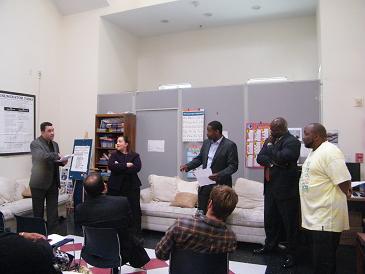I recently asked Deputy City Attorney Yvonne Mere about the criteria the city uses to determine if someone is a member of a criminal street gang.
More precisely, I wanted to know if any of the 41 young black men named in City Attorney Dennis Herrerra’s recently filed gang injunction in Visitacion Valley were named simply because they were seen affiliating with documented gang members and frequenting gang areas.
I asked because those are two criteria local law enforcement officials use to classify gang members.
According to Penal Code Section 186.22, a minimum of two or more of the following criteria must be met to classify someone as a member of a criminal street gang:
1. Subject has admitted to being a gang member (to any peace officer, school official, or juvenile hall employee).
2. Subject has committed gang-related crimes or engaged in gang-related activities.
3. Subject has been identified as a gang member by a reliable informant/source.
4. Subject has been identified as a gang member by an untested informant or source with corroborative evidence.
5. Subject has been seen affiliating with documented gang members.
6. Subject has been seen displaying symbols and/or hand signs.
7. Subject has been seen frequenting gang areas.
8. Subject has been seen wearing gang clothing.
9. Subject has identifiable gang tattoos.
10. Subject is a registered gang member under Penal Code section 186.30
OR—as a single criteria:
11. Subject admits being a gang member in a custodial classification interview.
“I don’t have a cheat sheet that says X has number 3, 7 and 10 on that list,” Mere replied. “But I will tell you that this is not the case that these guys just happen to be hanging out in the area, and weren’t committing crimes, but just got swept up.”
Mere pointed to one of the declarations posted at the City Attorney’s website that alleges that one individual admitted to being a gang member, and was also convicted of second degree robbery, arrested in felony possession of firearms and ammunition, has been seen in the neighborhood with other documented gang members, frequenting gang areas and throwing a Down Below Gang’s hand sign.
“Our expert declaration lays out all the criteria,” Mere said. “And we have an opt out provision,” she added, noting that the Lawyer’s Committee has said it will help anyone with the opt-out petition. “But so far no lawyers or individuals have contacted us about opting out.”
Another expert declaration documents how the SFPD received a tip that gang members had buried a weapon after a chase with the police and that when the SFPD recovered the firearm, they found fingerprints of one of the individuals now on the Viz Valley list.
The declaration says that this individual was then arrested and found with a plastic baggie containing ten off-white rocks of suspected rock cocaine between his buttocks.
Another individual named on the list allegedly took police on a chase through the Britton Courts public housing project and was seen stopping to bury a small off-white object, which allegedly turned out to be two bags of suspected meth. On arrest, this individual, who is not on the Britton Courts lease, was found with a bag of marijuana on his person.
I asked Mere if the City Attorney’s gang injunction could be impacted if voters approve Prop.19, which would legalize the sale of marijuana.
“I can’t say how Prop. 19 is going to affect numerous cases that have a gang component,” Mere said. “I will tell you that we put everything on the table. We have laid out our entire case. It gives transparency. And a judge still has to decide if the evidence is sufficient.”
But if there is all this evidence, why isn’t the District Attorney’s Office prosecuting these 41 individuals on criminal charges (a process that would also automatically give these men the right to a Public Defender)?
“I think [folks in the D.A’s office] do,” Mere said. “But we’re still seeing that despite the best efforts of the police department, that the nuisance behavior still occurs. This is just another tool to stop the violence.”
Mere said none of the funding to put together this particular case came from federal sources.
“We are the same eight lawyers that do neighborhood nuisance abatement,” Mere said.

